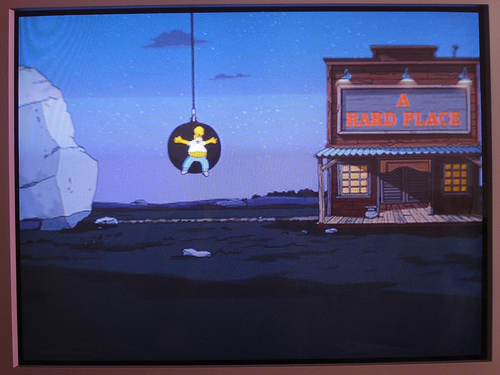 I’m stuck in the midst of conferences and end-of-year-accelerating projects, both adding to the workload (low-quality rock and the hard place picture of Homer ‘course copyrighted by Fox, obviously).
I’m stuck in the midst of conferences and end-of-year-accelerating projects, both adding to the workload (low-quality rock and the hard place picture of Homer ‘course copyrighted by Fox, obviously).
And next week will be filled to the brim with LeWeb. Still I wanted to conclude with me looking back at the e2conf in San Francisco and the E20SUMMIT in Frankfurt (yes, will post my other promised posts now …). One needs to use a blogging opportunity if it’s there, that is before all the interruptions that result from being better connected in this social web world will result in another dropdown of productivity on Monday morning …
This might well be one of the symptoms Kathleen Culver diagnosed at e20conf – that the attention erosion that comes with mutliple, real-time and intertwined activity streams may result in “an inability to perform deep analysis on whatever it is you’re working on”:
Research is suggesting the Enterprise 2.0 technologies might introduce negative impacts productivity, decision quality and job satisfaction, in addition to the positive ones. What do we need to be aware of as we unleash these solutions on employees?
[…]
Join me in challenging companies to address these soft challenges of Enterprise 2.0. Challenges that can potentially dilute the benefit of E2.0 and maybe even make employees less productive and happy. Either take a moment to consider these issues when plunging forward with deployments or add your comments to the blog so we can raise the visibility of these challenges.
On the other hand I am a great fan of Clay Shirky’s meme of “filter failure, not information overload” – thus I am constantly on the search for better tools to filter and sort. That said, this constant search may be adding to the overload again …
 Yet I am expecting that the directory wave I prepared for LeWeb can help in collecting, systematizing and refining the various real-time content streams. Wave can be a very capable interactive venue, that’s allowing and enabling freeform collaboration, that is accesible and searchable by all, and that can help us master the “Information Candy Superstore” that LeWeb sure is going to be.
Yet I am expecting that the directory wave I prepared for LeWeb can help in collecting, systematizing and refining the various real-time content streams. Wave can be a very capable interactive venue, that’s allowing and enabling freeform collaboration, that is accesible and searchable by all, and that can help us master the “Information Candy Superstore” that LeWeb sure is going to be.
I told you already that I’m one of the official bloggers this year, hence you may find my writings, tweets and posts aggregated on many more places, Steph compiled some of the meta places to follow in here:
[…] You can also follow them all on Twitter with the official bloggers list. During the conference, you will be able to find all their posts about LeWeb’09 on a single page, with a single feed (thanks to Superfeedr). Another way to access their publications is through the LeWeb’09 Pearltree — just click on the Official Bloggers branch.